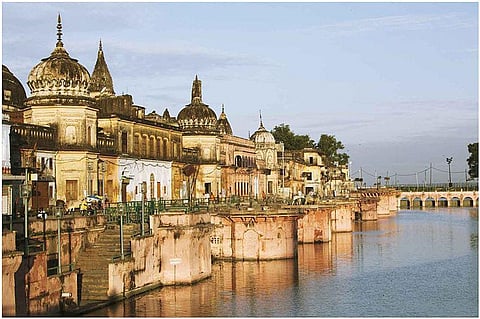
- Home
- न्यूजग्राम
- NewsGram USA
- India
- World
- Politics
- Entertainment
- Culture
- Lifestyle
- Economy
- Sports
- Sp. Coverage
- Misc.
- NewsGram Exclusive
- Jobs / Internships

Ayodhya, August 9, 2017: If you hail from Ayodhya in Uttar Pradesh, would you believe us if we said you might have some distant cousins in Korea? Researchers discovered in the last decade that Korea and Ayodhya have a shared history and traced Korean roots to the pious Hindu city.
It is widely believed that travelers from both these countries not just traded goods but also shared genes. Professor Byung Mo Kim, who is a Professor Emeritus of Hanyang University and a national archaeologist from Korea, believes that he shares his genes with Ayodhya's royal family. "I hail from Kara dynasty, whose first woman was the princess of Ayodhya, who married the first Kara king. Her brothers went on to become the kings of Ayodhya", he said explaining his genetic connection to the holy city.
Ayodhya in Uttar Pradesh plays host to hundreds of South Koreans every year, who visit the holy Hindu city to pay tribute to their legendary queen Hur-Hwang-ok.
If you are wondering what a Korean Queen was doing in the Hindu holy city, the queen, also known as Princess Suriratna, is believed to have been the princess of Ayodhya before she went to South Korea and married King Kim Suro of Karla Clan in 48 AD. Thus, Professor Kim regards princess Suriratna as the "daughter of Ayodhya" and added that it is in this manner that Ayodhya is their maternal home.
According to Korean legends, the princess was only 16-year-old when she traveled to Korea and got married to King Suro of Geumgwan Gaya and became his first queen. It is also popularly believed that the Princess was the mother of descendants who brought together multiple Korean kingdoms in the 7th century, making Karak the largest clan in Korea. Thus, it is due to this connection that more than 70 lakh Koreans hold the holy city of Ayodhya in reverence as their maternal home.
The princess is believed to have traveled from Ayodhya to South Korea on a boat, with a stone in her hand that is believed to have calmed the seas on her voyage. The legends also state that it was only because of this stone that she could safely make the journey.
The twin fish stone that the Princess was carrying is the state symbol of Ayodhya and is touted as the biggest clue to the link. Claiming that he has pictorial evidences, the Professor believes the stone to have traveled from the Mediterranean region to this part, eventually settling in Lucknow.
"But the same twin fish symbol can also be seen in ancient buildings in Pakistan, Nepal, China, Japan, and the gate of royal tomb of King Suro in Kimhae city in Korea", added Professor Kim, reasserting his claim.
Till date, there is very little awareness in India about Queen Suriratna as not much information has been documented. During Prime Minister Narendra Modi's visit to Seol in May 2015, it was announced that the two countries will strengthen their historic ties by enhancing linkages of the Korean population with Ayodhya. A decision was also taken to renovate the monument already in place in Ayodhya, dedicated to the Queen, for which the then-UP CM had asked Korean government to devise a design.
NewsGram is a Chicago-based non-profit media organization. We depend upon support from our readers to maintain our objective reporting. Show your support by Donating to NewsGram. Donations to NewsGram are tax-exempt.
Click here- www.newsgram.com/donate
